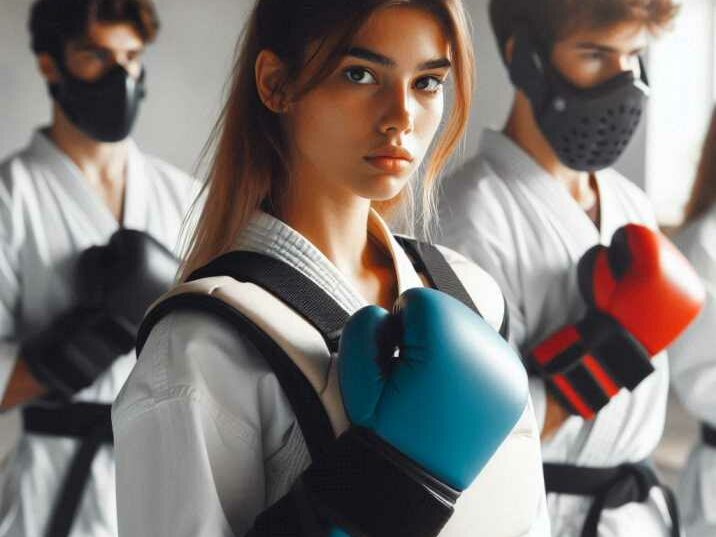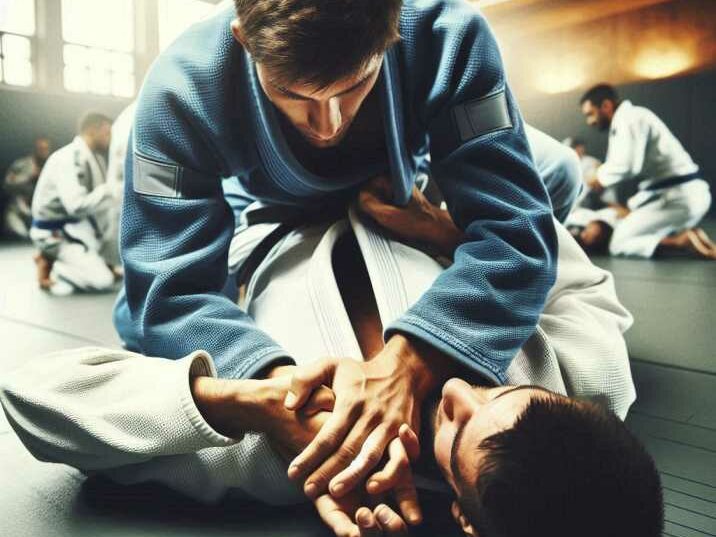Combat sports are exciting and full of action, but they can also be dangerous. When we talk about combat sports, we think of boxing, wrestling, judo, karate, and more. But not all combat sports are the same when it comes to safety. Some are much safer than others. In this article, we will explore which combat sport is the safest for kids and beginners. We will look at the rules, equipment, and techniques that make a sport safer and provide some interesting facts and figures. Whether you’re curious about trying a new sport or just want to learn more, this guide is here to help you make an informed decision.

Understanding Combat Sports
Table of Contents
Combat sports are athletic activities that involve one-on-one fighting. These sports can include striking, grappling, or a combination of both. Each sport has its own set of rules and techniques that determine how competitors can attack and defend.
Common Types of Combat Sports
- Boxing: In boxing, fighters use their fists to strike their opponents. The goal is to land punches on your opponent while avoiding being hit yourself.
- Wrestling: Wrestling is a grappling sport where competitors try to pin their opponents to the ground or force them to submit.
- Judo: Judo focuses on throws and holds, aiming to unbalance the opponent and take them to the ground.
- Karate: Karate involves striking with hands and feet, using kicks and punches to score points or defeat an opponent.
- Brazilian Jiu-Jitsu: Brazilian Jiu-Jitsu (BJJ) is a grappling art that focuses on ground fighting and submission holds.
- Taekwondo: This sport emphasizes kicking techniques, along with punches, to score points.
What Makes a Combat Sport Safe?
When considering safety in combat sports, several factors come into play. Here are some key elements that make a sport safer:
Protective Gear
Protective gear is crucial in minimizing injuries in combat sports. Here’s how each piece of equipment contributes to safety:
Headgear
- Purpose: Headgear is designed to protect the head and face from injuries, such as cuts and bruises. It also helps absorb the impact of blows to the head, which can reduce the risk of concussions.
- Usage: Headgear is commonly used in sports like boxing, taekwondo, and amateur martial arts competitions.
Mouthguards
- Purpose: Mouthguards protect the teeth, lips, and mouth from damage. They help cushion the impact of strikes to the jaw and reduce the risk of broken teeth and jaw injuries.
- Usage: Mouthguards are essential in almost all combat sports, including boxing, MMA, and karate.
Gloves
- Purpose: Gloves are used to protect the hands and wrists of fighters and to reduce the impact of strikes on opponents. They help prevent fractures and soft tissue injuries to the hands.
- Usage: Gloves are a staple in sports like boxing and MMA, where striking is a primary component.
Rules and Regulations
Rules and regulations are put in place to ensure fairness and safety during competition. Here’s how they help:
Weight Classes
- Purpose: Weight classes ensure that competitors are evenly matched in size and strength. This prevents larger, stronger fighters from having an overwhelming advantage over smaller opponents, reducing the risk of serious injury.
- Usage: Most combat sports, including boxing, MMA, and wrestling, use weight classes to promote fair and safe competition.
Time Limits
- Purpose: Time limits help prevent fighters from becoming overly fatigued, which can lead to poor decision-making and increased risk of injury. They also ensure that matches remain competitive and manageable.
- Usage: Time limits are applied in rounds or periods in sports like boxing, MMA, and wrestling.
Scoring System
- Purpose: A scoring system encourages fighters to focus on technique and strategy rather than brute force. This helps reduce the likelihood of dangerous, uncontrolled actions that could lead to injury.
- Usage: Most combat sports use a point-based scoring system to reward technical skills, clean strikes, and controlled maneuvers.
Training and Technique
Proper training and technique are vital for safety in combat sports. Here’s why:
Proper Training
- Purpose: Learning the correct techniques helps athletes perform moves safely and effectively. Proper training minimizes the risk of self-inflicted injuries and helps athletes protect themselves during competition.
- Usage: Athletes in all combat sports undergo rigorous training to master techniques and improve their skills.
Supervised Practice
- Purpose: Supervised practice ensures that athletes learn and perform techniques correctly under the guidance of experienced coaches. This supervision helps identify and correct mistakes that could lead to injury.
- Usage: Supervised practice is essential in all combat sports, where coaches and trainers guide athletes in developing their skills safely.
Comparing Safety in Combat Sports
Boxing
Safety Equipment:
- Boxers wear gloves to protect their hands and reduce the impact of punches on their opponents.
- Mouthguards are used to protect the teeth and mouth.
- Headgear is worn in amateur matches to provide additional protection against head injuries.
Injury Risks:
- Head injuries are a significant concern in boxing due to repeated punches to the head, which can lead to concussions and other brain injuries.
Safety Measures:
- Strict weight classes ensure that fighters compete against opponents of similar size and strength, reducing the risk of injury from mismatched fights.
- Medical checks are conducted before and after matches to monitor the health of the fighters.
Brazilian Jiu-Jitsu (BJJ)
Safety Equipment:
- Practitioners wear a gi, a traditional uniform that provides grip for techniques but offers no additional protective gear.
Injury Risks:
- BJJ is less impact-focused than striking sports, but joint injuries can occur due to submission holds.
Safety Measures:
- Emphasis is placed on technique and control, allowing practitioners to apply holds safely.
- The practice of tapping out allows practitioners to concede before an injury occurs, making it safer than sports where athletes endure repeated impacts.

Judo
Safety Equipment:
- Judokas wear a gi and sometimes use mouthguards for additional protection.
Injury Risks:
- The risk of injury comes from throwing techniques, which can lead to falls. However, the use of mats helps cushion impacts.
Safety Measures:
- Training focuses on safe falling methods and proper techniques to minimize injury during throws and grappling.
Karate
Safety Equipment:
- Competitors wear gloves, mouthguards, and sometimes shin guards to protect against strikes.
Injury Risks:
- Striking can lead to bruises and fractures, but the sport encourages controlled contact to prevent serious injuries.
Safety Measures:
- The scoring system rewards controlled and precise techniques rather than forceful hits, encouraging safer practices.
Taekwondo
Safety Equipment:
- Includes headgear, chest protectors, and shin guards to minimize injury from kicks and strikes.
Injury Risks:
- High kicks can lead to leg injuries, but protective gear reduces the impact.
Safety Measures:
- The sport emphasizes speed and technique over power, promoting safer practices through agility and precision.
Why Brazilian Jiu-Jitsu is Considered Safe
After comparing these combat sports, Brazilian Jiu-Jitsu emerges as one of the safest options for several reasons:
Focus on Technique
- Emphasis on Skill: BJJ focuses on skill and technique rather than brute strength. Practitioners learn to control opponents using leverage and body mechanics, which reduces the reliance on physical power.
- Grappling and Control: BJJ involves grappling and ground fighting, where the objective is to control and submit the opponent without striking. This minimizes the risk of head injuries common in striking sports.
Tapping Out
- Safety Mechanism: The concept of tapping out allows practitioners to concede the match if they feel they are in a vulnerable or potentially harmful position. This voluntary submission prevents injuries and ensures safety during practice and competition.
Minimal Striking
- Reduced Head Injuries: Unlike sports such as boxing or karate, BJJ involves minimal striking. The focus on grappling and submissions significantly reduces the risk of head injuries and concussions.
Supervised Training
- Experienced Instructors: BJJ classes are typically overseen by experienced instructors who prioritize safety and proper technique. This supervision ensures that students practice safely and learn effective techniques.
Adaptive for All Ages
- Suitable for Everyone: BJJ can be adapted for practitioners of all ages, making it a suitable and safe choice for children, adults, and families. The sport’s adaptability and focus on technique make it accessible and engaging for beginners and experienced athletes alike.
Safety Statistics
- Lower Injury Rate: A study by Johns Hopkins University found that BJJ has a lower rate of injury compared to other combat sports. The study highlighted fewer instances of concussions and long-term injuries, making BJJ one of the safer options.
- Practitioner Feedback: According to a survey, over 70% of BJJ practitioners reported feeling safer in BJJ compared to other combat sports they had tried. This feedback underscores the sport’s reputation for safety and the confidence it instills in its practitioners.
Information Table: Which Combat Sport is the Safest?
| Sport | Protective Gear | Main Techniques | Injury Risks |
|---|---|---|---|
| Boxing | Gloves, Mouthguards, Headgear | Punching | Head injuries |
| Brazilian Jiu-Jitsu | Gi, No additional gear | Grappling, Submissions | Joint injuries |
| Judo | Gi, Mouthguards | Throws, Holds | Falls |
| Karate | Gloves, Mouthguards, Shin Guards | Punches, Kicks | Bruises, Fractures |
| Taekwondo | Headgear, Chest Protectors, Shin Guards | Kicks, Punches | Leg injuries |
Conclusion: Choosing the Right Combat Sport
When choosing a combat sport, safety is an important factor to consider. Brazilian Jiu-Jitsu emerges as a top choice for those looking for a safe, engaging, and challenging sport. Its focus on technique, minimal striking, and emphasis on safety make it ideal for beginners and experienced practitioners alike.
If you’re interested in exploring a combat sport, try visiting local gyms or classes to see which one feels right for you. Remember, no matter which sport you choose, practicing under the guidance of a qualified instructor is key to staying safe and enjoying the sport.
FAQs
- Which combat sport has the least injuries?
- Brazilian Jiu-Jitsu generally has fewer injuries compared to other combat sports due to its emphasis on technique and safety.
- Is boxing safer than MMA?
- Boxing is generally considered safer than MMA because it involves only punching, while MMA includes kicks, elbows, and ground fighting.
- Can children practice Brazilian Jiu-Jitsu safely?
- Yes, children can safely practice Brazilian Jiu-Jitsu under proper supervision and with age-appropriate techniques.
- What protective gear is essential for combat sports?
- Essential protective gear includes mouthguards, headgear, and gloves, depending on the sport.
- How can I reduce the risk of injury in combat sports?
- To reduce the risk of injury, focus on learning proper technique, use appropriate protective gear, and practice under the guidance of an experienced instructor.


